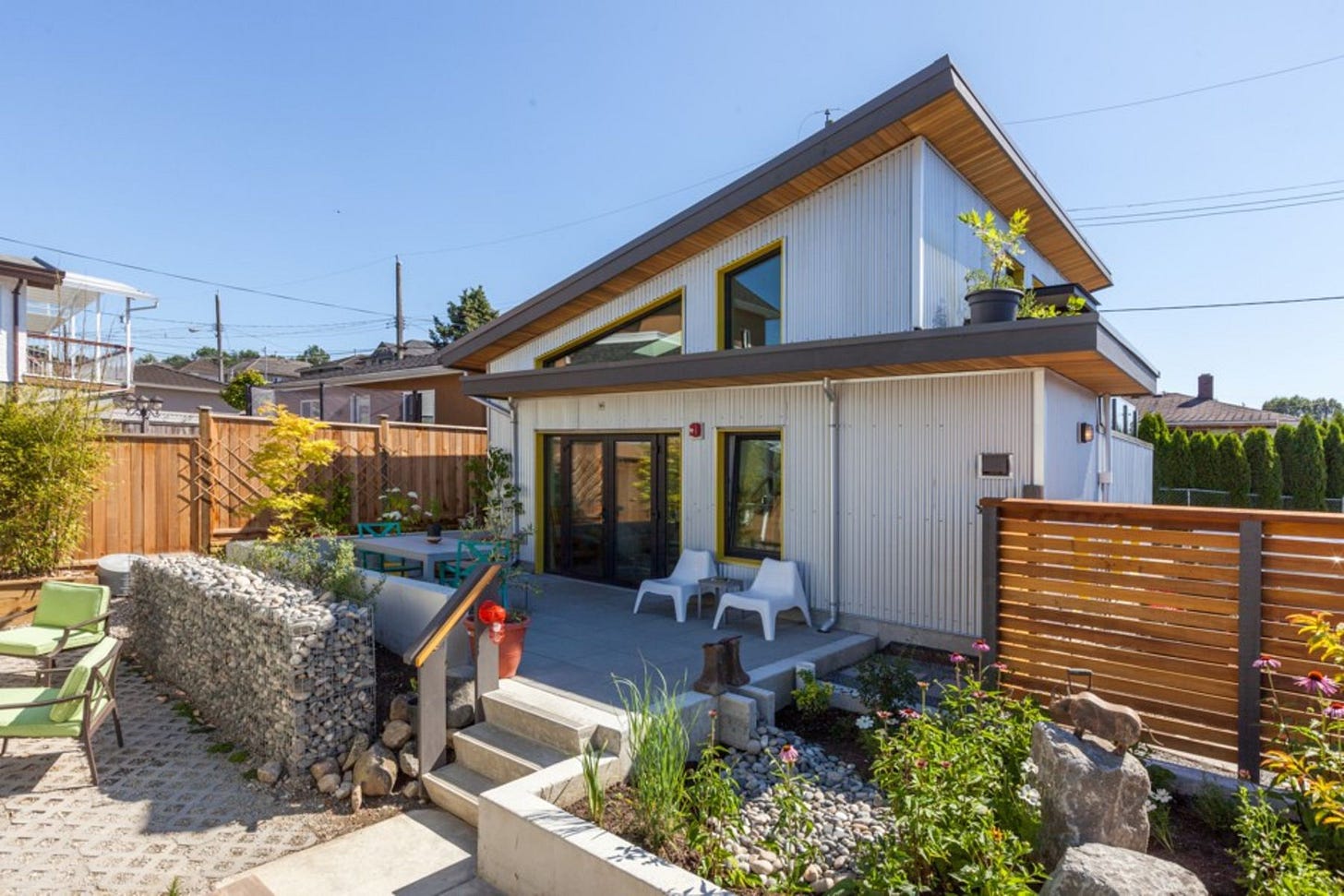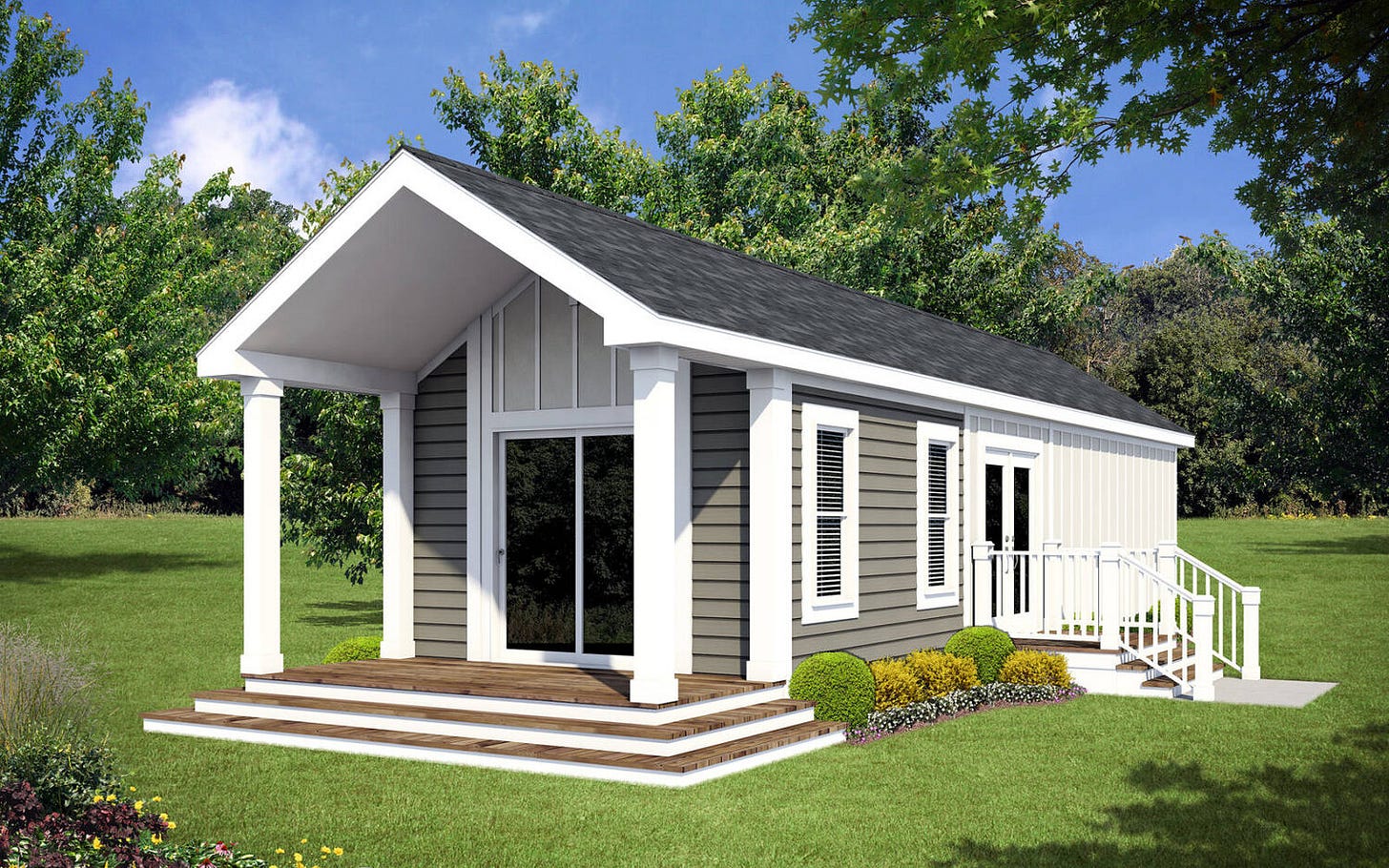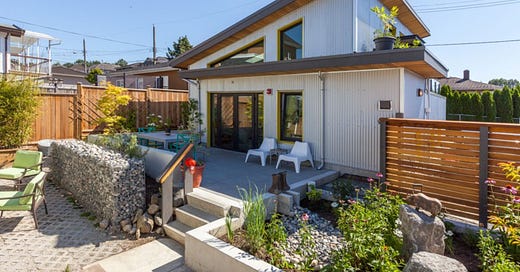Another Year of the ADU?
With public policy stuck in gridlock, some communities, lenders, and developers are getting creative.
Welcome to issue #1 of Brick & Mortar.
I’ll be honest. It’s not easy hitting publish on your first piece of writing. Lot of what ifs flying around in your head.
But there are more important things out there than a bruised ego. So, at the risk of sounding self-deprecating, hopefully you’ll find a bite of value here. At the very least, you might get a couple good links to other, better content writers :)
And, in the event you like my writing and want to read more of it, all it takes is an email to subscribe.
Enjoy.
A Few Things Worth Sharing
🎧 Listen: Richard Florida on the Strong Towns podcast. A look at talent migration patterns and how cities will fare post-Covid. Florida is an urban studies theorist at Carnegie Mellon University.
📺 Watch: Urbanized — a documentary about urban design and the built environment. Always intriguing to hear from Jan Gehl about the great work being done in Copenhagen.
📚 Read: Daniel Parolek’s Missing Middle Housing. The bible of incremental development. This will change the way you think about urban design, planning, and development.
The Rise and Fall (and Rise Again) of Accessory Dwelling Units
Think of an Accessory Dwelling Unit (ADU) as that apartment your parents added onto to your house for grandpa when he moved in. Then forget that thought. Because they are so much more than that.
An ADU is really any secondary, livable space added onto a single-family plot of land. They can be attached or detached, and come in all shapes and sizes:
Garage conversion
Basement finishing
Wing addition
Free-standing construction behind a house

ADUs have been gaining traction in recent decades, particularly on the west coast. But why? Well, let’s take a step back.
The term “ADU” is effectively just an industry-wide rebranding effort for a development practice that’s been going on forever.
And, a decent effort at that judging from the almost 9% annual growth rate in permitted ADUs built over the past 20 years.
Homeowners have been adding on granny flats — or Ohana units, sidekicks, Next Gens, dawdy houses, take your pick — as far back as owning a home first became a thing. For a long time, it served as a great tool to enable multi-generational living. Son getting married and starting a family? Throw up an extra room or addition to accommodate them. Problem solved.
It wasn’t until after WWII that zoning laws came into effect and municipalities began to regulate ADU development. Consumption of mass-produced vehicles and FHA-backed loans surged. Quickly, the American Dream became synonymous with owning an unbastardized single-family home in the suburbs. In the end, ADUs were effectively banned and modern-day suburban sprawl was born.
As the 20th century moved on, consumer demand started to change. Demographic and housing needs began to shift towards higher density development. But, by that point, it was too late.
Decades of public policy and private demand had ossified the rigid zoning codes that persist today. Dwelling units per acre became the metric that decided entire neighborhoods’ fates — the de facto dictator silencing creative solutions to the growing housing crisis in their infancy.
While some progress has been made on modernizing zoning codes, it has been slow. And heated debates rage on the public policy front. Important discussions ranging from national entitlement programs like Social Security and Medicare to battles over gentrification in urban centers continue to delay consensus.
Despite the intense gridlock over the larger housing discussions, a lower-profile and readily-available solution has begun to re-emerge. In the form of… you guessed it… ADUs.
Some municipalities have stepped up to the plate by allowing the use and construction of accessory units. Although other barriers still exist (as we’ll get into), this is the first step in paving the way for wider ADU adoption. Vermont, for example, now requires municipalities to allow homeowners to add one ADU to their house.
The Hype Surrounding ADUs
You might be wondering so what, why should I care?
From a macro standpoint, this is important for two reasons:
There is currently a shortage of 2.5 million housing units across the US
75% of the land in many American municipalities is zoned exclusively for single-family residences
Long story short — there is a massive opportunity to start filling the gap in housing units today with tools that already exist.
To put this in perspective, Freddie Mac identified 1.4M ADUs in existence as of 2019 (legal and unpermitted). That accounts for less than 2% of the 83M detached single-family homes in the US.
And it’s not just economists and policy makers getting excited over this. There are real, tangible benefits for homeowners, too:
Passive income. Earn a few hundred extra dollars in rental income each month after expenses are paid. Of course, this will depend on your construction costs and rental market.
Higher property valuation (forced appreciation). In some instances, an ADU added 50% onto the home’s value.
Multigenerational living. The age-old use. In fact, older Americans are no longer the largest consumer of multigenerational housing today. In 2014, more 18-to-34-year-olds lived with their parents than in other arrangements for the first time in 130 years.
Flexibility. In addition to being used as a long-term rental, an ADU can serve as additional office space, a guest house, or an AirBnb.
Eco-friendly. ADUs can cut CO2 emissions by almost 40% over a lifetime compared to the traditional family home. They also provide much-needed housing without creating the need to develop and build on new lots.
No, ADUs aren’t perfect — they won’t solve the housing crisis single-handedly. And, yes, there are folks that either enjoy their freedom too much or will be turned around by the excessive red tape within their towns or cities. However, at the end of the day, they provide a real opportunity to start tackling a problem that will require a multimodal solution.
But of Course There’s Red Tape
Even with many states and municipalities moving to legalize ADUs (shoutout to you, NY), there are still a number of obstacles remaining for homeowners:
Off-street parking. My town, for example, requires one off-street space per bedroom. A planned 2-bedroom ADU can quickly vanish into nothing more than a pipe dream on a 3,000 square foot lot.
Setbacks. Towns often require a 10-15’ buffer around the edge of the property where no permanent structures can be built.
Floor Area Ratios (FARs). Constraints on how much impervious structure can cover a lot (building and pavement included). Often, municipalities want to leave some degree of land undeveloped on a property (up to 55% in some cases).
Owner-occupancy. The owner of the property must have their primary residence on the same lot as the ADU. Typically, the main house.
Impact fees. Every time a new connection is made to municipal sewer or water system, the property owner pays a fee. These can quickly become burdensome to a small ADU development if separate utilities are desired.
Most towns and cities enforce some combination of the above. Each of these has a very real impact on the economics of developing an ADU and can quickly derail a project.
Another hurdle is that the typical ADU developer is a homeowner. This usually means they have little to no true development experience. Finding and working with architects, engineers, and subcontractors from start to finish can be a daunting task, especially while juggling a full-time job. Add in the opaque permitting process plus the tenant management on the backend and soon you’re left thinking why the hell would I sign up for this?
I wouldn’t go as far to say it’s every homeowner’s civic duty to add an ADU on their property (though some would). My background is in business, so I tend view things through a lens of return on investment.
At the end of the day, developing an ADU should be an investment decision. The numbers have to make sense. Determining feasibility, analyzing costs, accounting for your time and effort, and calculating the upside — this is what the decision should ideally boil down to.
On the bright side, ADU development is getting easier (generally speaking). As ADUs gain popularity, people are documenting their experiences, municipalities are relaxing regulations, and banks are designing better-suited financial products. All this progress makes for a smoother experience for future homeowners.
Let’s take a look a some of this progress made to date.
Getting Creative and Taking Action
Local Government
Take Vancouver. Starting in the 1980s, the city began to legalize thousands of existing, but illegal, ADUs. Over time, it was slowly able to peel back and reform the decades of prohibitive ADU policies, including:
Removal of additional off-street parking requirements
Removal of owner-occupancy requirements
Additional occupancy limits for each dwelling on a property
Greater freedom in homeowner design choice including size, height, and placement
By 2016, Vancouver achieved 35% penetration of ADUs within the single-family market. That’s over 26,000 additional housing units created in one city alone.
Now contrast that to the 1% penetration rates in both Portland and Seattle, both leaders in the American ADU market.

Going one step further, there’s Boston. Between 2017-2019, the city launched an ADU pilot program where they removed red tape in the zoning process in addition to offering up to $30,000 in zero-interest loans to homeowners.
The program was wildly successful, with the city now moving to expand the program and make it permanent.
Financing
ADU financing has traditionally been limited to savings, HELOCs, cash-out refinances, family loans, or personal credit cards.
Making one of these options work can be difficult for many folks, especially if they don’t have much equity in their primary residence. Thankfully, some lenders have begun to get creative:
Renovation loans. Fannie Mae and Freddie Mac offer products that allow homeowners to obtain a loan based on the anticipated property value after renovation. Lenders, such as Umpqua Bank on the west coast, have begun to sell these products to consumers.
Income-based underwriting. Smaller lenders with less than $10B in assets have more regulatory flexibility with their appraisal methodologies, allowing them to use an income-based approach during underwriting. For example, Silicon Valley Housing Trust’s ADU program allows for up to 75% of projected ADU rent to be used as qualifying income for the applicant.
However, use of creative financing solutions like the ones above are limited and are not widely adopted. In fact, they should be seen as successful proofs of concept, capable of wide-spread implementation. Other lenders could leverage this data and experience to develop their own programs modeled on what works.
Developers
This one’s my favorite, and demonstrates how a for-profit business model could support wide-spread ADU adoption.
Dweller is a specialized developer that builds and installs prefabricated (prefab) ADUs. Prefab just means the ADUs are built offsite in a warehouse. Benefits here include scalability, faster development, and lower cost to the homeowner.

What’s innovative about Dweller is their pilot program with eight homeowners in Portland. Dweller covers the cost of construction in exchange for entering into a long term ground lease with the homeowner. Dweller retains ownership of the ADU, manages rental activities, and shares 25% of the profits with the homeowner. The homeowner is given the option to purchase the ADU outright at any point.
I love this concept because it’s a win-win-win. The homeowner wins by sharing the upside without all the risk or hassle. The public wins by getting a new apartment at 80% of the median family income (workforce housing). And Dweller wins by making a little money.
Dweller isn’t the only one in this space. United Dwelling in Los Angeles and ADU Builder in Palo Alto are successfully using similar business models.
Feeling Inspired?
If you’re a homeowner or developer, I’d recommend digging into Backdoor Revolution: The Definitive Guide to ADU Development by Kol Peterson. Peterson is one of the top thought leaders on ADU development based in Portland. He also owns the Tiny House Hotel.
For everyone else — town officials, planners, community activists, etc. — it’s time to start rethinking single-family zoning bylaws. We should all be working with our local planning commissions and lenders to educate and pull them in the right direction.
Forbes prematurely deemed 2020 the year of the ADU. I think 2020 was the year of a lot of things, perhaps just not the ADU. We should continue focus on making incremental improvements and driving this as a bottoms-up reform.
Parting Thoughts
As a small-scale developer, I’m constantly on the lookout for other developers to draw inspiration and ideas from. Particularly, those making an impact. Here are a few rockstars to follow:
Matt McPheely and his Chapel project in Greenville, NC. He also writes a great newsletter and discusses philosophical issues in the real estate industry — like the dangers of treating real estate as just another asset class.
Jenifer Acosta and her development company in Bay City, Michigan. She also blogs — check out How to Buy a Property in 14 Days, a crazy story of how she bought 10 flood-affected condos to turn them into missing middle housing.
Bernice Radle and Buffalove Development in Buffalo, NY. “My number one thing is to cannonball right in.” Love the attitude and determination.
Thanks for reading.
Until next time,
Jonah (@jonahhrichard)








Really solid summary, Jonah. Thanks for the insights and inspiration. Having just moved out of a progressive town in California I can attest to the rising tide of ADU demand and the easing of restrictions to get them done. There was quite a bit of pressure on the municipalities from the CA government to put in ADUs, so there are political points to be scored for local administrators to support this type of development as well.
Advice on convincing the authorities that ADUs can fit zoning?